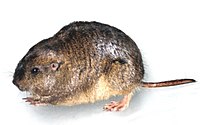Tuco-tuco
| Tuco-tuco Temporal range: Late Pliocene–Recent |
|
|---|---|
 |
|
| Female Patagonian tuco-tuco | |
| Scientific classification | |
| Kingdom: | Animalia |
| Phylum: | Chordata |
| Class: | Mammalia |
| Order: | Rodentia |
| Suborder: | Hystricomorpha |
| Infraorder: | Hystricognathi |
| Parvorder: | Caviomorpha |
| Superfamily: | Octodontoidea |
| Family: |
Ctenomyidae Lesson, 1842 |
| Genus: |
Ctenomys Blainville, 1826 |
| Species | |
|
see text |
|
see text
A tuco-tuco is a neotropical rodent in the family Ctenomyidae. Tuco-tucos belong to the only living genus of the family Ctenomyidae, Ctenomys, but they include approximately 60 different species. The common name, "tuco-tuco" comes from the "tuc-tuc" sound they make while they dig their burrows.
The relationships among the species are debated by taxonomists. It has been described that they are in a state of "taxonomic chaos," but banded karyotypes have been used to help make progress on their taxonomic study. Their closest relatives are degus and other octodontids. All species of tuco-tucos are found in South America from Peru and central Brazil southward. The tuco-tucos of South America have an ecological role equivalent to that of the pocket gophers of North America.
They occupy an ecological niche previously taken by gondwanatheres such as Patagonia earlier in the Cenozoic.
Tuco-tucos have heavily built cylindrical bodies with short legs and their pelage ranges in color from black to light grey. Their skin is loosely applied, possibly to slide about the tunnels they create. They have long fore feet for burrowing, and bristled hind feet for grooming. They also have large heads, small ears, and hairy tails. Their bodies range in size from 15–25 cm (5.9–9.8 in) in length, and they can weigh as little as 100 grams (C. pundti) to more than 1000 grams (C. conover).
Members of the genus Ctenomys are widely distributed, but over 50 of the species are found in the southern half of South America. They can be seen in many areas from the southern portion of Peru and southern Brazil to the Tierra del Fuego at the southernmost tip of South America, through parts of Chile and a majority of Uruguay, Paraguay, Bolivia, and Argentina. Their ranges occur from coastal grasslands to mountain slopes, including the Andean Puna at over 4000 meters, and depend on factors such as soil type, ambient temperature, and primary productivity. The only sympatric distribution of this genus occurs between C. australis and C. talarum in a coastal dune region.
...
Wikipedia
